을지로에는 개업한 지 수십 년이 된 오래된 식당들이 많다. 이곳에서 일하는 사람들의 든든한 한 끼를 책임져 온 노포는 음식 맛도 일품이어서 외지에서 일부러 찾아오는 사람들도 많다. 대부분의 노포는 대를 이어 운영되고 있으며, 그 역사만큼이나 많은 이야깃거리들을 간직하고 있다.
The alleyways of Euljiro are lined with family-owned restaurants and pubs that have served hearty meals and refreshing drinks for generations. The traditional haunts of Euljiro’s workforce now also attract young locals, tourists, and art enthusiasts who enjoy the food as much as Euljiro’s colorful history.
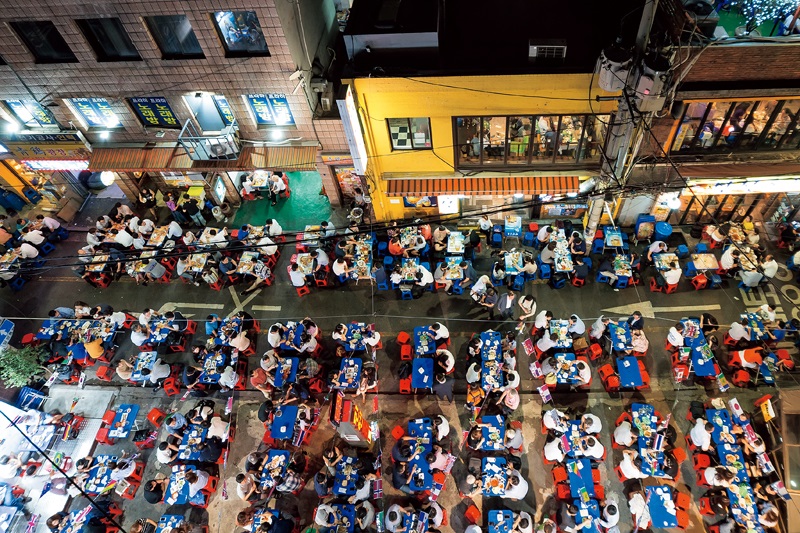
서울 한가운데 자리한 을지로는 노포가 많은 대표적인 지역이다. 골목마다 인쇄소, 철공소, 목재소 등이 들어서 있는 이곳에는 낡은 간판을 내건 식당과 술집들도 즐비하다. 1960년대 말에는 한국 최초의 주상복합 건물인 세운상가가 건립되면서 사람들로 더욱 북적였다. 1980년대까지만 해도 부러울 게 없을 정도로 번성했던 이 일대는 점차 낙후된 지역이 되었다. 빠른 속도로 급변한 한국의 산업 구조 때문이었다. 인쇄 종이는 빠르게 컴퓨터 파일로 대체됐다. 늦은 밤까지 빛났던 공장의 불빛은 점차 어둠 속으로 사라져 갔다.
Euljiro in downtown Seoul is home to many nopo, best described in English as long-standing family businesses. These old bars and restaurants share narrow alleyways with print, metal, and wood workshops. Euljiro began to flourish in the late 1960s with the construction of Sewoon Plaza, the first commercial-residential complex in Korea. During the 1970s, the area was the epicenter of Korea’s postwar economic boom, but it began to decline in the wake of rapid changes in the country’s industrial structure. Workshops where craftsmen burned the midnight oil closed down one by one and customers at local businesses began to thin.
수명을 다한 듯했던 거리는 2010년대 말부터 되살아나기 시작했다. 옛 모습 그대로인 골목과 공장에 예술가들은 공방이나 스튜디오를 차렸다. 예술가들이 모이자 골목은 생기를 되찾기 시작했고, 노포 앞에는 음식을 맛보려는 사람들로 긴 줄이 생겼다. 을지로의 노포들은 오랫동안 그저 낡고 오래된 식당, 나이 지긋한 노인들이나 그곳에서 생계를 유지하는 사람들이 주로 가는 곳으로 인식되었다. 그러나 최근 을지로가 핫플레이스가 되면서 이곳에 자리 잡고 있는 노포들도 젊은 세대 사이에서 인기 있는 맛집의 반열에 오르게 되었다.
Euljiro eventually rebounded in the late 2010s when fledgling artists gravitated here and took over vacant spaces that were uncharacteristically cheap considering their prime location. New art studios and workshops reenergized the area and attracted a new generation of visitors. Soon, the Euljiro nopo became hotspots among young art aficionados, proving that their great food and retro vibe had never really lost their allure.
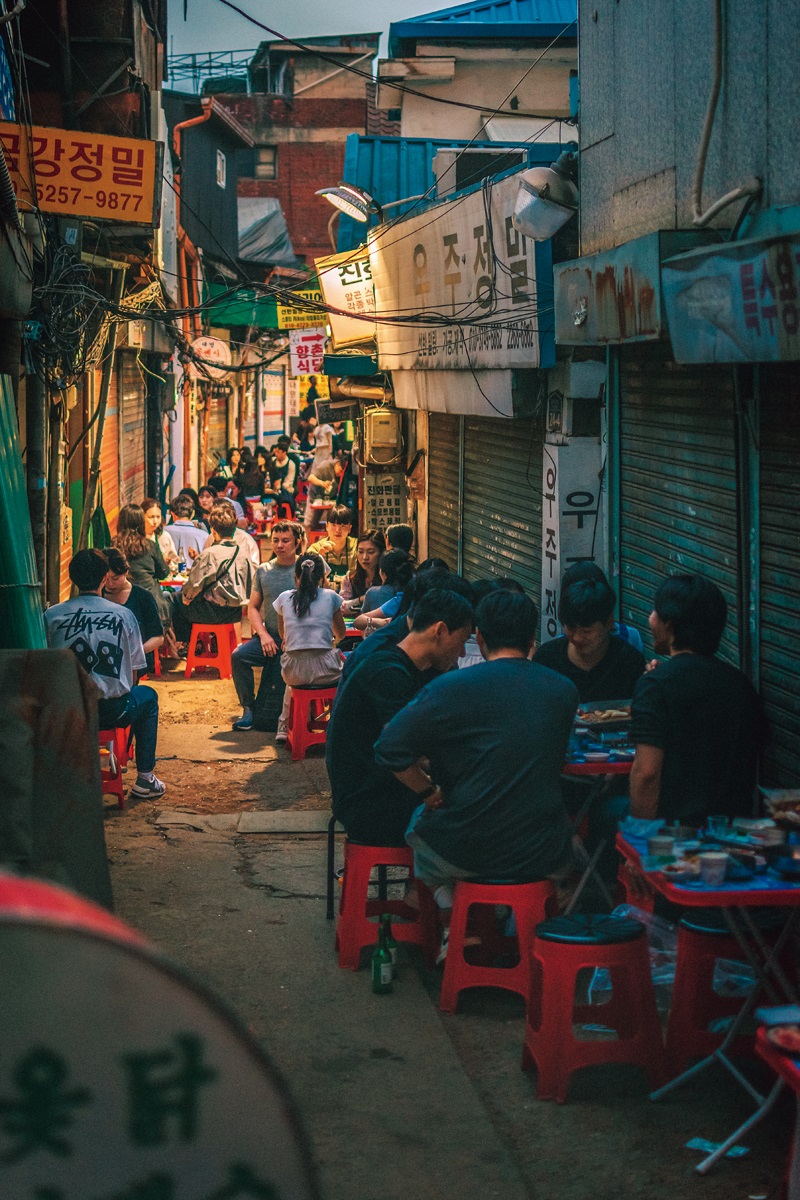
소문난 평양냉면 가게 – NORTHERN NOODLES
평양냉면은 현재 북한의 수도인 평양(平壤) 지역의 향토 음식이다. 장시간 끓인 고기 육수에 메밀국수를 말아서 먹는 음식이다. 1930년대 평양 사람들이 서울에 진출해 냉면집을 내면서 여름철 최고의 별미가 되었고, 점차 대중화되었다. 평양냉면은 밍밍한 육수에 돌돌 말아서 담은 면, 그 위에 올린 채 썬 배와 달걀 지단이 전부이다. 언뜻 보기엔 별다른 맛이 없을 것 같지만, 먹으면 먹을수록 담백한 맛에 끌리게 되는 음식이다.
Pyongyang naengmyeon, as the name suggests, is a local specialty of the North Korean capital. When people from Pyongyang opened naengmyeon restaurants in Seoul in the1930s, it caught on as a summer delicacy and gradually gained widespread popularity. The simple, unpretentious dish consists of buckwheat noodles served in a meat broth that is simmered for a long time before being chilled. Swirled into a small pile and placed in a deep bowl, the noodles are often garnished with pear slices and half of a hardboiled egg.
지하철 을지로4가역에서 걸어서 1분 거리에 있는 우래옥(Woo Lae Oak, 又來屋)은 미식가들이 손에 꼽는 평양냉면 가게다. 1946년 가게를 차린 장원일(張元一) 씨 부부도 평양에서 왔다. 1972년 그가 세상을 떠난 후에는 후손들이 대를 이어 지금까지 운영한다. 처음 문을 열었을 때 이름은 서북관(西北館)이었다. 서북은 한반도의 북쪽에 위치한 평안도, 함경도, 황해도 지방을 통틀어 이르는 말이다. 개업하고 4년 뒤 한국전쟁이 발발하면서 주인 내외도 다른 이들처럼 가게 문을 닫고 피난을 떠나야 했다. 전쟁이 끝난 후 다시 영업을 재개하면서 현재의 이름을 간판으로 내걸었다. ‘다시 찾아온 집’이라는 뜻이다.
Woo Lae Oak, located a one-minute walk from Euljiro 4-ga subway station, is a favorite among foodies seeking this northern noodle dish. Hailing from Pyongyang, Jang Won-il and his wife Na Jeong-il started the restaurant in 1946. Since Jang’s passing in 1972, his descendants have continued his legacy. The restaurant’s original name was Seobukgwan, with seobuk referring to the Pyongan, Hamgyong, and Hwanghae Provinces in the northern end of the Korean peninsula.The Korean War erupted four years after the restaurant’s opening, forcing Jang and Na to flee, but they later returned and reopened under the current name, which means “at home again.”
우래옥은 날이 갈수록 번창해 하루에 2천 그릇을 판 적도 있다고 한다. 을지로에서 생계를 이어가는 사람들뿐 아니라 외지에서도 많이 찾아왔다. 지방에서 서울에 놀러 온 이들은 창경궁을 관람하고는 꼭 이곳에 들러 냉면을 먹고 갔다. 맛의 비결은 소고기를 오랜 시간 끓여 만든 육수에 있다. 면의 재료가 되는 메밀의 함량도 높다. 매우 부드러워서 입 안에 넣자마자 면이 후루룩 넘어간다. 우래옥에 평양냉면만 있는 건 아니다. 가장자리가 오목하고 가운데가 불룩 솟아난 불판에 구워 먹는 불고기 맛도 일품이다. 심심한 듯하면서 달곰한 양념은 불고기의 풍미를 배가시킨다. 외국인 손님들도 이 불고기를 좋아한다.
Woo Lae Oak’s business thrived and its record for sales of Pyongyang naengmyeon in a single day is 2,000 bowls. Today, customers include both locals and out-of-towners, many of whom stop by after having toured nearby Changgyeong Palace. Another of the restaurant’s specialties is bulgogi. Thin slices of meat, usually beef, are cooked on a table-top grill with concave edges and a raised center. A sweet marinade enriches the flavor of the dish, making it a favorite among foreign guests.
우래옥과 더불어 을지로 지역의 소문난 평양냉면 가게로 을지면옥이 있었다. 1985년 개업한 이 가게는 같은 자리에서 약 40년 동안 냉면을 만들어 팔았다. 도심 재개발로 인해 퇴거한다는 소식이 알려지자 많은 사람들이 아쉬워했고, 2022년 6월 25일 마지막 영업일에는 가게 문이 열리기도 전에 100여 명의 손님들이 찾아와 길게 줄을 서서 기다렸다. 이들은 을지면옥의 마지막 순간을 함께했다.
Eulji Myeonok was another famous Pyongyang naengmyeon restaurant in Euljiro. Opened in 1985, it operated at the same location for decades, and for a while, it seemed as if it might survive the area’s urban redevelopment. A group of long-established property owners had sued Jung District to have its approval of the project reversed, and the city responded by announcing plans to try and preserve Euljiro’s living heritage. Ultimately, it was to no avail, and so, before opening time on June 25, 2022, more than 100 people lined up in front of Eulji Myeonok for a final, memorable bowl of cold noodles.
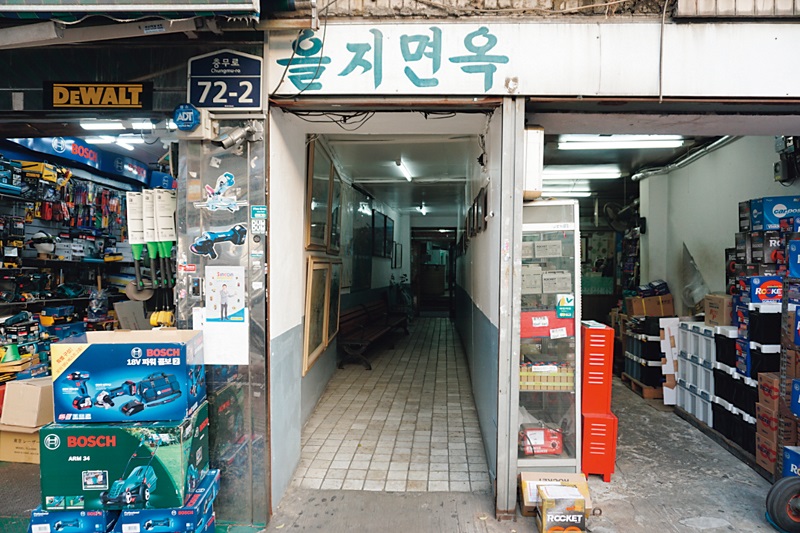
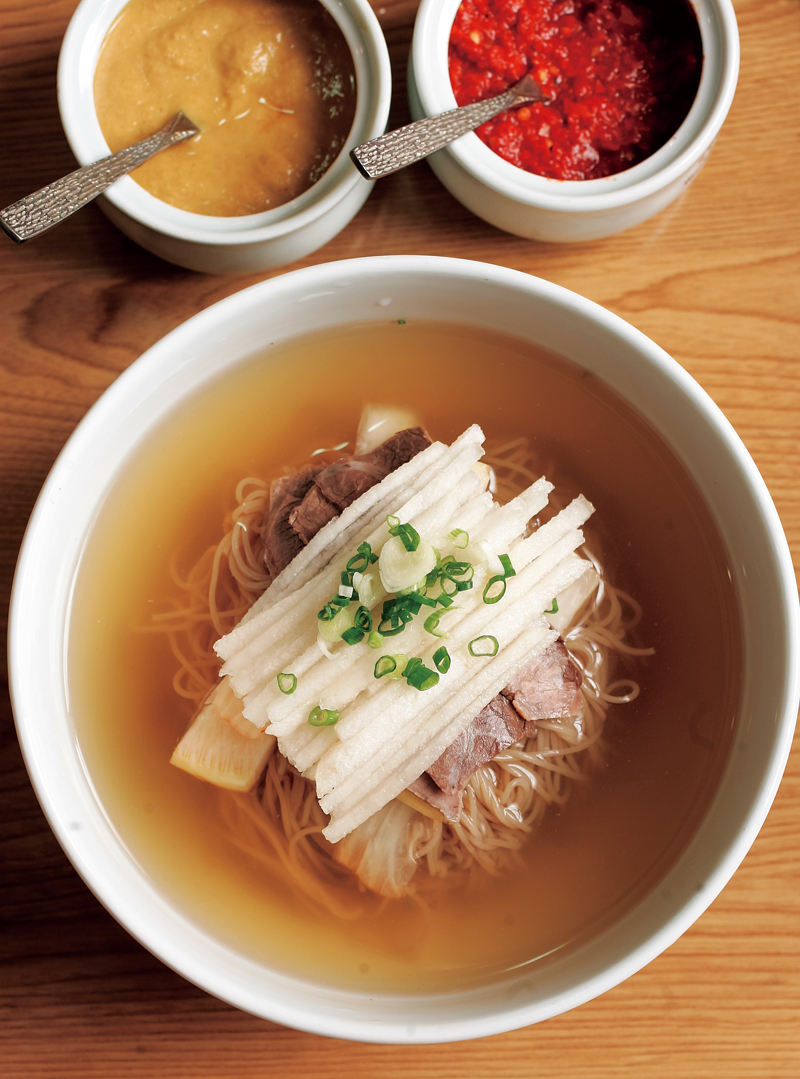
맥주 골목의 시작 – BIRTH OF NOGARI ALLEY
중소벤처기업부는 2018년부터 ‘백년가게’ 사업을 벌이고 있다. 30년 이상 명맥을 유지하면서 고객들에게 꾸준히 사랑받아 온 점포 가운데 역사적 가치가 있고 앞으로도 성장 가능성이 있는 곳을 선정하여 지원하는 정책이다.
In 2018, the Ministry of SMEs and Startups addressed the challenges faced by local entrepreneurs by launching the Hundred-Year Store Development Plan. The objective was to select and support businesses with historical value and growth potential that had been in operation for more than 30years.
을지OB베어(Eulji OB Bear)는 시행 첫해에 백년가게로 선정되었다. 1980년 개업한 이 가게는 생맥주를 판다. 생맥주는 신선함을 유지하는 것이 중요하기 때문에 가게 주인은 생맥주 통을 상온에 그냥 두지 않고 온도 제어 장치가 설치된 냉장고 안에 보관하며 관리한다. 겨울에는 4℃, 여름에는 2℃를 유지한다. 이 집이 유명해진 데는 언제 가더라도 항상 신선한 생맥주를 마실 수 있다는 이유도 있지만, 그보다는 안주로 내놓는 노가리구이 덕분이라 할 수 있다. 노가리는 명태 새끼를 말한다. 가게 주인은 잘 말린 노가리를 연탄불에 노릇노릇하게 구워서 자신이 만든 고추장 소스와 함께 제공했다. 주머니가 가벼운 직장인들이 부담 없이 먹을 수 있도록 가격도 매우 저렴하게 책정했다.
Opened in 1980, Eulji OB Bear, known for its draft beer, appeared on the Hundred-Year Store list in the project’s first year. Since freshness is key to exceptional draft beer, first-generation owner Kang Hyo-keun stored his kegs in a refrigerator set at 4 °C in winter and 2 °C in summer. The establishment was famous not only for its beer but also grilled nogari. The dried young pollock was placed over red-hot coal briquettes until golden brown and served with homemade red pepper paste. It paired perfectly with the affordably priced beer that allowed even those on a tight budget to buy more than one round.
고소하게 구워진 노가리는 단박에 손님들을 사로잡았다. 맥주 안주로는 이만한 게 없었다. 입소문이 나면서 19.8㎡밖에 되지 않은 작은 술집은 발 디딜 틈이 없을 정도로 사람들이 몰렸다. 시간이 흐르면서 주변에 맥줏집들이 하나둘 생겨났고, 새로 생긴 가게들에서도 노가리 안주를 팔았다. 사람들은 을지로 3가에 위치한 이 골목을 ‘노가리 골목’이라 부르기 시작했고, 우리나라를 대표하는 맥주 골목으로 자리 잡게 되었다. 코로나19 팬데믹 이전에는 해마다 5월 맥주 축제가 벌어져 골목에 흥겨움이 넘쳐났다. 서울시는 2015년, 이 골목의 가치를 인정하여 서울미래유산으로 지정했고, 을지OB베어를 노가리 골목의 원조로 명시했다.
When Eulji OB Bear opened its doors, word spread quickly. The 19.8-square-meter pub was soon packed to capacity on a regular basis. Over time, nearby competitors also serving nogari as a bar snack popped up one after another, earning the street nationwide fame and the nickname Nogari Alley. This culminated in an annual beer festival, held each May in pre-pandemic times, that filled the street with an air of excitement. The Seoul Metropolitan Government selected the alleyway as Seoul Future Heritage in 2015 and recognized Eulji OB Bear as the originator of Nogari Alley.
노포의 비애 중 하나는 건물주와의 마찰이나 도시 재개발로 인한 이전 문제다. 이 집도 예외는 아니었다. 바뀐 건물주와 5년간 법정 다툼 끝에 2022년 4월 강제 철거되었다. 가게를 아끼는 단골손님들과 시민단체가 철거 반대 시위를 벌인 것은 유명한 일화다. 이곳은 2023년 3월 마포구 경의선(京義線) 책거리 인근에 새롭게 문을 열었지만, 을지로로 다시 돌아갈 날을 꿈꾼다.
Nopo commonly face conflict with property owners and eviction due to urban redevelopment, and Eulji OB Bear was no exception. Kang’s daughter Kang Ho-shin and her husband Choi Su-young, who had taken over the management in the early 2010s, eventually lost a years-long legal battle against the building’s new owner, and the cherished pub was forcibly demolished in April 2022. Neither its heritage designation nor protests by regulars and civic groups shielded it from the landlord’s business ambitions. Although the couple reopened near Gyeongui Line Book Street in Seoul’s Mapo District in March 2023, they never gave up hope of returning to Euljiro. And so it came that on February 16, 2024, the legendary establishment made its triumphant comeback, reopening just 50 meters from Exits 9 and 10 of Euljiro 3-ga subway station.

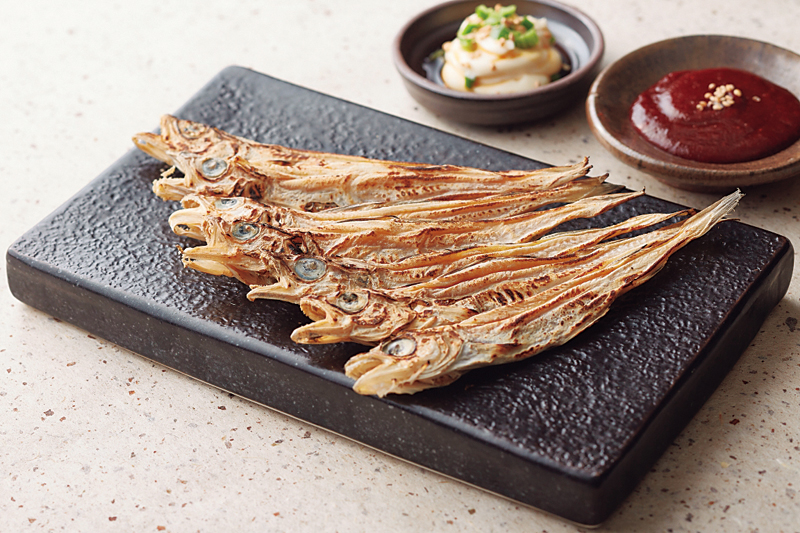
한결같은 맛과 정성 – COMMITMENT TO TASTE
이 외에도 조선옥, 문화옥, 양미옥 등이 을지로를 대표하는 노포들이다. 이 중에서 역사가 가장 오래된 곳은 1937년 문을 연 조선옥이다. 이 식당은 서울에서 제대로 된 갈비를 먹을 수 있는 곳으로 꼽힌다. 소갈비를 진간장, 참기름, 마늘, 설탕 등 갖은양념에 하루 정도 재웠다가 연탄불에 구워 내는 것이 맛의 비결이다. 창업주의 아들 김정학(金貞學) 씨는 현재도 발행되고 있는 잡지 『월간 바둑』을 창간한 사람으로 유명하다.
Other famous Euljiro nopo are Chosunok, Munhwaok, and Yangmiok. Chosunok, which opened in 1937, is the place to go for a true taste of beef galbi, or Korean short ribs. The secret to their extraordinary flavor is soaking them for a day in a marinade containing dark soy sauce, sesame oil, garlic, and sugar, and then grilling them over coal briquettes. The founder’s son, Kim Jeong-hak, is well-known as the publisher of Monthly Baduk, a magazine about the popular board game.
을지로4가역 인근에 있는 문화옥은 1952년 개업한 설렁탕 가게이다. 사골과 양지로 육수를 내 국물이 진한 것이 특징이다. 조선옥과 함께 을지로 3가에서 수십 년 동안 자리를 지켰던 양미옥은 1992년 개업한 양곱창 전문점인데, 고 김대중(金大中) 대통령이 자주 찾던 집으로 명성을 크게 얻었다. 그러나 안타깝게도 2021년 화재로 전소되어, 현재는 남대문 분점이 그 맛을 이어가고 있다. 세월이 흐르면 노포도 외형적 변화를 겪기 마련이지만, 한결같은 맛과 정성으로 찾아오는 이들을 반기는 것은 예나 지금이나 같다.
Munhwaok, near Euljiro 4-ga Station, opened in 1952. The restaurant offers seolleongtang, or ox bone soup, a dish loved by many for its rich broth made from beef leg bones and brisket. Yangmiok is a decades-old establishment in Euljiro 3-ga, which opened in 1992. Specializing in grilled beef tripe, it gained fame when late President Kim Dae-jung became a frequent diner here. Unfortunately, a fire destroyed the original restaurant in 2021, but its culinary legacy lives on in the Namdaemun area, home to Korea’s largest traditional market. Despite the challenges faced by nopo over the years, their owners’ dedication remains steadfast and their offerings continue to entice patrons’ taste buds.
박미향(Park Mee-hyang, 朴美香) 음식 저널리스트
Park Mee-hyang: Food Journalist
